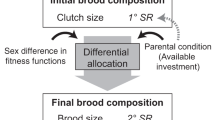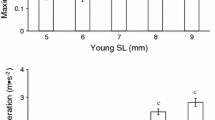Summary
We review parental investment decision theory and provide an experimental test of the decision rule used by male bluegill sunfish (Lepomis macrochirus) in allocating parental investment to their young. The alternative decision rules tested are: (1) invest according to brood size (number) only; (2) invest according to past investment only; (3) invest according to both brood size and past investment; and (4) invest according to neither brood size nor past investment. By manipulating brood size independently of a male's cumulative investment in the brood, and by measuring each male's defensive behavior against a model predator, we found that male bluegill invest according to both brood size and past investment. This result is consistent with recent theory that past parental investment devalues adult future reproductive value, and that animals should therefore invest according to the value of their brood relative to that of their own expected future reproduction.
Similar content being viewed by others
References
Avila VL (1976) A field study of nesting behavior of male bluegill sunfish (Lepomis macrochirus Rafinesque). Am Midl Nat 96:195–206
Bain MB, Helfrich LA (1983) Role of male parental care in survival of larval bluegills. Trans Am Fish Soc 112:47–52
Barash DP (1975) Evolutionary aspects of parental behavior: distraction behavior of the alpine accentor. Wilson Bull 87:367–373
Biebach H (1981) Energetic costs of incubation on different clutch sizes in starlings (Sturnus vulgaris). Ardea 69:141–142
Boucher DH (1977) On wasting parental investment. Am Nat 111:786–788
Carlander KD (1977) Handbook of freshwater fishery biology, vol 2. Iowa State University Press, Ames
Carlisle TR (1982) Brood success in variable environments: implications for parental care allocation. Anim Behav 30:824–836
Carlisle TR (1985) Parental response to brood size in a cichlid fish. Anim Behav 33:234–238
Charlesworth B (1984) The evolutionary genetics of life histories. In: Shorrocks B (ed) Evolutionary ecology. Blackwell, Oxford, pp 117–134
Colgan PW, Gross MR (1977) Dynamics of aggression in male pumpkinseed sunfish (Lepomis gibbosus) over the reproductive phase. Z Tierpsychol 43:139–151
Dawkins R (1976) The selfish gene. Oxford University Press, Oxford
Dawkins R, Brockmann HJ (1980) Do digger wasps commit the Concorde fallacy? Anim Behav 28:892–896
Dawkins R, Carlisle TR (1976) Parental investment, mate desertion and a fallacy. Nature 262:131–133
Dominey WJ (1981) Anti-predator function of bluegill sunfish nesting colonies. Nature 290:586–588
Fagerstrom T (1982) Maternal investment, female rivalry, and a fallacy. Oikos 39:116–118
Grafen A, Sibly R (1978) A model of mate desertion. Anim Behav 26:645–652
Gross MR (1980) Sexual selection and the evolution of reproductive strategies in sunfishes (Lepomis: Centrarchidae). PhD thesis, Utah, University Microfilms International, Ann Arbor, Mich
Gross MR (1982) Sneakers, satellites and parentals: polymorphic mating strategies in North American sunfishes. Z Tierpsychol 60:1–26
Gross MR, Nowell WA (1980) The reproductive biology of the rock bass, Ambloplites rupestris (Centrarchidae), in Lake Opinicon, Ontario. Copeia 1980:482–494
Gross MR, MacMillan AM (1981) Predation and the evolution of colonial nesting in bluegill sunfish (Lepomis macrochirus). Behav Ecol Sociobiol 8:163–174
Hubbs CL, Lagler KF (1958) Fishes of the Great Lakes region. University of Michigan Press, Ann Arbor
Iersel JJA van (1953) An analysis of the parental behaviour of the male three-spined stickleback (Gasterosteus aculeatus L.). Behav Suppl 3:1–159
Keast A (1978) Trophic and spatial interrelationships in the fish species of an Ontario temperate lake. Environ Biol Fish 3:7–31
Kramer DL, Liley NR (1971) The role of spawning behaviour and stimuli from the eggs in the induction of a parental response in the blue gourami, Trichogaster trichopterus (Pisces, Belontiidae). Anim Behav 19:87–92
Kramer DL (1973) Parental behaviour in the blue gourami Trichogaster trichopterus (Pisces, Belontiidae) and its induction during exposure to varying numbers of conspecific eggs. Behaviour 47:14–32
Maynard Smith J (1977) Parental investment: a prospective analysis. Anim Behav 25:1–9
Maynard Smith J (1978) Optimization theory in evolution. Annu Rev Ecol Syst 9:31–56
Orians GH (1969) On the evolution of mating systems in birds and mammals. Am Nat 103:589–604
Pressley PH (1981) Parental effort and the evolution of nestguarding tactics in the threespine stickleback, Gasterosteus aculeatus L. Evolution 35:282–295
Robertson RJ, Biermann GC (1979) Parental investment strategies determined by expected benefits. Z Tierpsychol 50:124–128
Rohwer S (1978) Parent cannibalism of offspring and egg raiding as a courtship strategy. Am Nat 112:429–440
Sargent RC (1985) Territoriality and reproductive tradeoffs in the threespine stickleback, Gasterosteus aculeatus. Behaviour 93:217–226
Sargent RC, Gross MR (1985) Parental investment decision rules and the Concorde fallacy. Behav Ecol Sociobiol 17:43–45
Sargent RC, Gross MR (in press) Williams' principle: an explanation of parental care in teleost fishes. In: Pitcher T (ed) The behaviour of teleost fishes. Croom Helm. London
Sokal RR, Rohlf FJ (1981) Biometry, 2nd edn. Freeman, San Francisco, Calif
Stearns S (1980) A new view of life-history evolution. Oikos 35:266–281
Trivers RL (1972) Parental investment and sexual selection. In: Campbell B (ed) Sexual selection and the descent of man 1871–1971. Aldine, Chicago, Ill, pp 136–179
Unger LM (1983) Nest defense by deceit in the fathead minnow, Pimephales promelas. Behav Ecol Sociobiol 13:125–130
Weatherhead PJ (1979) Do savannah sparrows commit the Concorde fallacy? Behav Ecol Sociobiol 5:373–381
Weatherhead PJ (1982) Risk-taking by red-winged blackbirds and the Concorde fallacy. Z. Tierpsychol 60:199–208
Williams GC (1966) Natural selection, costs of reproduction and a refinement of Lack's principle. Am Nat 100:687–690
Williams GC (1975) Sex and evolution. Princeton University Press, Princeton, NJ
Author information
Authors and Affiliations
Rights and permissions
About this article
Cite this article
Coleman, R.M., Gross, M.R. & Sargent, R.C. Parental investment decision rules: a test in bluegill sunfish. Behav Ecol Sociobiol 18, 59–66 (1985). https://doi.org/10.1007/BF00299238
Received:
Accepted:
Issue Date:
DOI: https://doi.org/10.1007/BF00299238




